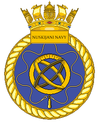Nuskijani Navy
| Nuskijani Navy | |
|---|---|
 | |
| Country |
|
| Type | Navy |
| Role | Naval Warfare |
| Size |
|
| Part of | Nuskijani Armed Forces |
| Naval Headquarters | Port Wolfsmouth |
| Nickname | High King's Fleet |
| Motto | "The King's Seas Tamed" |
| Colors | Black, Gold |
| March | "Oar and Anchor" |
| Anniversaries | 1 January 1937 |
| Fleet |
|
| Commanders | |
| High King of the Kingdom of Nuskijan | Baunell XIV |
| Admiral of the Navy | Carson Germain |
| Chief of Naval Staff | xxx |
| Insignia | |
| Naval Crest | |
| Aircraft Roundel | |
The Nuskijani Navy is the maritime arm of the Nuskijani Armed Forces. Dating to 1681, the Nuskijani Navy is one of the oldest naval forces in Greater Dienstad. Originally formed to halt rampant piracy off Nuskijan's northern coasts, the navy has since grown into a modern blue water fleet. Today, the Nuskijani Navy's primary purpose is sea control and homeland defense.
The Nuskijani Navy consists of five branches, the Nuskijani Naval Aviation Arm, Nuskijani Navy Logistics Arm, and Nuskijani Navy Marines, Nuskijani Navy Surface Forces, and the Nuskijani Navy Submarine Forces. Formed from these branches are four fleets. Two fleets are designated expeditionary, one fleet is designated as a territorial defense unit, and the fourth fleet is a reserve component capable of being attached to either expeditionary fleets or the territorial defense fleet, or acting independently.
The Navy is responsible to the High King of Nuskijan, along with four other service branches. The current senior-most officer of the Nuskijani Army is Admiral of the Navy Carson Germain, a direct subordinate to the High King. Admiral Germain is also member of the six-man Committee of War, which is responsible for organization, preparation, use of forces, as well as planning and programming, equipment acquisitions, and conscription. As of 2019, the Nuskijani Navy employs xxx,xxx personnel, and xx,xxx personnel in reserve, comprised of discharged conscripts who volunteer for reserve status in exchange for a small stipend and mandatory monthly training.
Contents
Origins
The Nuskijani Navy traces its origins to the High King's Fleet, formed in 1681 as the very first act of the newly appointed High King Baunell I. The piracy situation along the northern coast was becoming unbearable, and reports of pirates and free people raiding coastal villages and towns were common. Baunell I ordered the construction of one Ship of the Line and three galleys. Construction was delayed at Port Wolfsmouth by pirate attacks, and was finally completed in 1685. Prior to completion of the first four ships of the High King's Fleet, the High King ordered the various ships of the lower kings to begin aggressive counter-piracy patrols. These patrols were met with disaster as the untrained crews fell victim to rough seas and the pirates' superior firepower. Recognizing such losses as unacceptable and intending to protect the Kingdom's investment in the four warships under construction, the Baunell I formed the first naval college at Port Wolfsmouth, the Royal College of Naval Warfare and ordered the most seasoned and experienced sailors within the kingdom to the city to begin training a naval force capable of performing under such harsh conditions.
Between 1685 and 1703, the pirates were gradually defeated and the pirates no longer posed a significant threat to the northern coasts. In a speech to the High King and the royal court, the Commandant of the Fleet gave a rousing speech, stating "the King's seas have been tamed." This became the origin of the current motto, which has been in use since 1704.
History
Organization
The chief of naval staff is Vice Admiral xxx, and as of 2019 the Navy has an active strength of xxx,xxx military personnel and xx,xxx civilian staff. The Navy is organized into five main operational branches:
- The Naval Aviation Arm
- The Naval Logistics Arm
- The Naval Infantry (Marines)
- The Surface Forces
- The Submarine Forces
Since the 1950's, the navy has been organized into four fleets, one each based in Port Wolfsmouth, Blackbury, Hewe, and Astonville. These cities are also home to significant civilian ports and provide infrastructure necessary for maintenance and resupply.
As of 2019, the largest Nuskijani naval base is the military port of Port Wolfsmouth. Other major bases are the Blackbury Arsenal, Hewe Naval Base and Astonville Naval Base. The Naval Aviation Arm is headquartered at Naval Air Base Walden, with other major bases at Naval Air Base Darkwell and Naval Air Station Dalhurst.
Equipment
Ships and submarines
Nuskijani Naval doctrine calls for each fleet to be comprised of one or more surface action elements, two aircraft carriers, and a subsurface action element. As of 2019, the Nuskijani Navy has 8 aircraft carriers; 4 escort carriers and 4 fleet carriers. There are plans to add a fifth fleet designed as a power projection and sea control force, but these plans have yet to materialize.
The Nuskijani Navy operates xx air defense destroyers, xx anti-submarine destroyers, xx multirole frigates, xx corvettes, xx amphibious assault ships, xx patrol craft, xx guided missile submarines, and xx attack submarines. In addition, the Navy operates xx minesweepers and xx at-sea replenishment ships.
Aircraft
The Nuskijani Naval Aviation Arm was created in 1991 by consolidating the previous land-based patrol squadrons and the aircraft carrier squadrons upon receipt of the first carrier. The Naval Aviation Arm completed a modernization process in 2012 by retiring the aging fighter, patrol, and AWACS aircraft. These squadrons have been fully re-constituted with new equipment and reached full operational capability in 2014. The main purpose of the Naval Aviation Arm is to provide carrier-based aircraft to the Navy's 8 aircraft carriers, but it is also responsible for shore-based patrol and surveillance aircraft, as well as rotary-wing operations.


